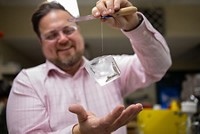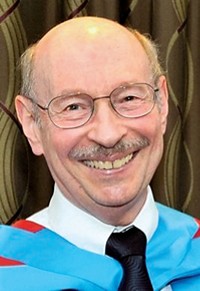Advertisement
Grab your lab coat. Let's get started
Welcome!
Welcome!
Create an account below to get 6 C&EN articles per month, receive newsletters and more - all free.
It seems this is your first time logging in online. Please enter the following information to continue.
As an ACS member you automatically get access to this site. All we need is few more details to create your reading experience.
Not you? Sign in with a different account.
Not you? Sign in with a different account.
ERROR 1
ERROR 1
ERROR 2
ERROR 2
ERROR 2
ERROR 2
ERROR 2
Password and Confirm password must match.
If you have an ACS member number, please enter it here so we can link this account to your membership. (optional)
ERROR 2
ACS values your privacy. By submitting your information, you are gaining access to C&EN and subscribing to our weekly newsletter. We use the information you provide to make your reading experience better, and we will never sell your data to third party members.
Physical Chemistry
Celebrating Crystallography
by Julia Chan , Jennifer Aitken , Susan Latturner
March 10, 2014
| A version of this story appeared in
Volume 92, Issue 10
This guest editorial is by chemistry professor Julia Chan, at the University of Texas, Dallas; associate chemistry professor Jennifer Aitken, at Duquesne University; and associate chemistry professor Susan Latturner, at Florida State University.
To commemorate the 100th anniversary of the Nobel Prize in Physics to Max von Laue “for his discovery of the diffraction of X-rays by crystals,” the United Nations has designated 2014 as the International Year of Crystallography. Scientists riveted by structure determination are celebrating crystallography, the science of the arrangement of atoms in solids. Crystallographic studies allow the determination of the positions of atoms in solids and lead to understanding of structure-property relationships of materials, which have health, environmental, energy, and technological applications.
X-ray diffraction has been a major driving force in modern materials science and other fields. The first solved crystal structure was that of table salt, but researchers can now solve the structures of materials with more than 1,100 atoms per unit cell, such as Gd117Co56Sn112. Rosalind Franklin’s X-ray diffraction images of DNA were crucial to elucidating DNA’s double helix. Max Perutz’s X-ray crystallography of hemoglobin gave birth to structural biology. Determining the three-dimensional structures of biological molecules now routinely provides information about biomolecular processes. Landmark achievements such as the structure determination of penicillin by Dorothy Crowfoot Hodgkin in 1946 have greatly influenced modern drug discovery and medicine.
Advances in instrumentation are revolutionizing the field. Synchrotrons, free-electron lasers, and neutron sources are enabling diffraction measurements that were not possible just a few years ago, as well as characterization of materials that do not even form single crystals. Accompanying these advances are breakthroughs in data analysis. The pair distribution function method, for instance, has greatly enhanced the structure determination of polycrystalline materials and has been applied to nanomaterials and macromolecular systems. Whole-pattern fitting X-ray powder diffraction data can provide details that are crucial to understanding the physicochemical properties of materials. Structures that once seemed unsolvable because of poor crystals are now solvable with the use of space groups in more than three dimensions.
Crystallography is sometimes unfairly characterized as a stolid activity. Far from it. Although a cursory understanding of the technique may allow one to solve and model simple structures, the challenge and fun come with quasicrystals and complex materials with disorder, superstructures, modulations, and defects. They require deftness, intuition, and a careful eye to discern the structural model that makes chemical sense.
In our training as solid-state chemists, we had opportunities to carry out crystal growth and structure determination of new materials in outstanding laboratories. These experiences inspired our careers and extended our understanding and appreciation of the reach of X-ray diffraction methods.
We urge the chemistry community to increase public awareness of such a science that, unfortunately, has been mostly lost in formal course offerings. Our community can encourage the next generation of scientists to learn and appreciate the richness of a discipline that interfaces with so many areas of science. A place to start is the U.S. National Committee for Crystallography publication “Crystallography Education Policies for the Physical and Life Sciences: Sustaining the Science of Molecular Structure in the 21st Century.” We should continue to communicate the immense influence and impact of crystallography on scientific endeavors.
To celebrate the International Year of Crystallography, we have organized a symposium, sponsored by the ACS Division of Inorganic Chemistry, at the ACS national meeting in Dallas “A Celebration of Crystallography in Solid-State and Materials Chemistry: Complex Problems and New Solutions in Inorganic Small-Molecule Crystallography” will take place on March 16 and 17. Speakers will discuss advanced crystallographic studies, instrumentation, computational packages, and use of national laboratories. Come and let the symposium introduce you to a technique that has been, and will continue to be, so impactful.
Julia Chan
Jennifer Aitken
Susan Latturner
Views expressed on this page are those of the author and not necessarily those of ACS.




Join the conversation
Contact the reporter
Submit a Letter to the Editor for publication
Engage with us on Twitter